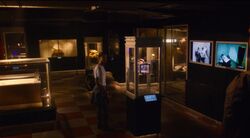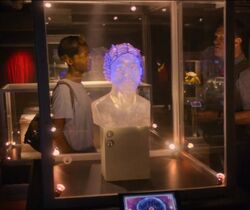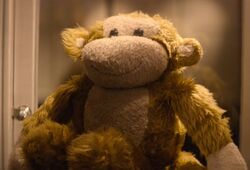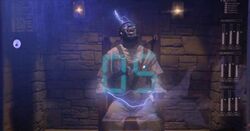| “ | If it did something bad, chances are it's in here. Take a look around, take your time, see what pops out at you. Anything piques your interest, I can tell you all about it. There's a sad, sick story behind most everything here... | „ |
| ~ Rolo Haynes |
The Black Museum is a roadside attraction appearing in the 2018 Black Mirror episode "Black Museum". Founded, owned and managed by Rolo Haynes, the building houses an extensive collection of authentic criminological artifacts from around the world, including items from past episodes of Black Mirror; at some point prior to the start of this episode, the Museum once enjoyed record profits based on its lurid entertainment factor, but protests over the main exhibit ultimately drove away most of Haynes' customers, forcing him to make do with a much more unpleasant client base in order to keep his business open for the foreseeable future - if at all. At present, the building serves as a part-time evil lair for Rolo Haynes - as well as a prison for the few artifacts unfortunate enough to possess a consciousness.
Overview
Situated somewhere in the deserts of Nevada, the Black Museum sits immediately adjacent to a lonely stretch of highway; as with many such roadside attractions, the museum building is next-door to a gas station in order to encourage visits from curious travelers who've stopped to refuel, but by the beginning of the episode, the BRB station has long since been shut down, further whittling away at Haynes' potential customers.
The Museum itself is contained entirely within a simple one-story building, ornamented with arches on one side of the facade and fitted with bars across the windows to prevent theft - for despite the faltering business, quite a few of the items inside are priceless artifacts. Other than the coat of black paint, little exists to distinguish the building apart from the distinctive sign on the roof: an eye-catching crimson display in the shape of a head exploding open from the back (as if shot), it is emblazoned with the words "Rolo Haynes' Black Museum," perfectly capturing the establishment's morbid, sensationalist atmosphere.
Past the glass doors, the front desk offers guests a variety of opportunities for enhancing their experience, including audiovisual headphone guides: a sign next to the headset rack indicates that certain exhibits marked with the headphone symbol provide audio tracks that attendees can listen to, including commentaries, interviews with criminals, or even 911 calls. However, security is still paramount, and all guests are required to pass through a metal detector before entering the main body of the collection.
From here, visitors are funneled through a corridor featuring a number of eye-catching screens displaying images and titles relating to the various exhibits, including text such as DOUBLE SUICIDE, CLONING WITHOUT CONSENT, AND CONSPIRACY TO KILL. The largest of these screens displays mugshots and sketches related to the trial of Victoria Skillane, the fiance and partner-in-crime to child killer Ian Rannoch. Beyond these displays, guests are led past a number of mannequins in murderous poses and a large collection of antique death masks, before finally entering the Museum concourse.
It is in this single large room that most of the exhibits can be found. Though some of them feature more commonly known examples of criminal history dating back to the 20th Century (a mugshot of Charles Manson can be seen, for example), the overwhelming items have been gathered from crimes that occurred during the 21st century, many of them related in some way to technology or tech-related abuses. The most precious of the relics - namely the ones that Haynes had a direct role in creating - are given pride of place in the glass display cabinets at the front of the concourse.
At the back of the concourse, Hayne's main attraction remains hidden behind a red velvet curtain; in this back room, Clayton Leigh's consciousness is stored, exhibited and regularly tortured for the amusement of what few guests remain.
Concourse Exhibits

The Concourse (DNA Scanner, Bathtub and Monkey in view).
Though only three of the exhibits are given direct focus over the course of the episode, many of the relics can be recognized from other episodes of Black Mirror, establishing that these events all took place within a shared continuity. These items include the following:
- The hanged body of Carlton Bloom (possibly a mock-up) from "The National Anthem".
- A mannequin dressed in Baxter's hunting gear and lambda mask from "White Bear".
- Mugshots and sketches of Victoria Skillane, also from "White Bear".
- The Cookie device used during Matt's virtual torture of Greta and Joe in "White Christmas".
- Security footage of Cooper's fatal testing session from "Playtest".
- The lethal VR headset, also from "Playtest".
- One of the ADIs used during Garret Scholes' terrorist attack in "Hated In The Nation".
- Robert Daly's DNA scanner (complete with Tommy's stolen lollipop) from "USS Callister"
- The broken Arkangel tablet from "Arkangel".
- The bloodstained bathtub in which Anan Akhand was murdered by Mia Nolan in "Crocodile.
Other possible references include the title "DOUBLE SUICIDE," which may be a reference to Jennifer's murder-suicide in "White Christmas," and the title "CONSPIRACY TO COMMIT MURDER" which may be a reference to one of the deadly pranks staged by the hackers in "Shut Up And Dance".
The Three Main Exhibits
Dawson's Symphatic Diagnoser

The Headset
| “ | Actually, that was one of my very first souvenirs. Sheds a little light on how our main exhibit came to be... | „ |
| ~ Haynes, upon being asked about the "hairdressing thing". |
Fitted over the scalp of a mannequin head contained within a large display case, the Diagnoser appears at first to be little more than a hairnet studded with electrodes. However, as Haynes makes clear, this is actually a piece of technological history that eventually played a role in the creation of the virtual paradise of San Junipero - along with the development of the Museum's main attraction.
Developed by TCKR Systems at St Juniper's Hospital, New York, the headset was originally part of an experimental attempt to instantaneously transfer knowledge between subjects, using a two-part process consisting of a transmitting headset and a receiving implant. After an initial attempt to share the layout of a maze between laboratory rats failed, it was soon discovered - after one of the researchers accidentally spilled a cup of coffee on one of the rats - that the process was actually a means of transmitting physical sensations.
Believing that this could potentially be used in order to help doctors more effectively diagnose their patients, the researchers entrusted Haynes (at that time employed by the hospital as a recruiter) with the duty of finding a member of staff willing to test their creation. The candidate they eventually located was one Dr Peter Dawson, a tragically inept MD currently in danger of being fired for his abysmal patient survival rate; after some persuasion from Haynes, Dawson agreed to be permanently fitted with the receiving implant.
Once he had built up a sufficient library of symptoms through extensive testing, Dr Dawson enjoyed unparalleled success: by allowing his patients to wear the Diagnoser headset, he was able to effectively deduce their condition in a matter of moments. Unfortunately, the creators of the device had not predicted what might happen if the implant were to transmit the sensation of death, and when one of Dawson's patients flatlined while he was wearing the headset, the unfortunate doctor was given the brunt of the transmitted data. The experience irrevocably warped his sensory perceptions, and from then on, Dawson felt pain as pleasure - and soon grew horrifically addicted to the suffering of his patients.
Suspended following a deliberate case of criminal neglect, Dawson soon resorted to mutilating himself in an attempt to enjoy the same high he'd felt from patients, and when that didn't work, stole the Diagnoser from the hospital and went hunting for victims. Dawson was eventually apprehended by police, but not before he'd murdered a homeless man with a cordless electric drill and ridden the ensuing high into a coma.
TCKR were eventually able to retrieve the Diagnoser from the police, but by then the researchers had lost interest in pain transference diagnosis, instead using it to begin studies of mind transference - ultimately rendering the headset obsolete and allowing Haynes to claim it as a souvenir.
Carrie the Monkey

"...monkey needs a hug..."
| “ | You ever had one of those relationships where you just can't get someone out of your head? | „ |
| ~ Haynes, telling Carrie's story. |
A simple plush toy in the shape of a monkey, this item is recognized by Haynes as "the saddest thing in this place." The toy has actually been fitted with a consciousness receptor, and as such, is currently playing host to the mind of a woman named Carrie Lamasse. Though fully equipped with cameras, audio receivers and even haptic sensors that allow for the sensation of touch, the monkey's communication system has been deliberately hard-wired so it can only say two phrases: "Monkey loves you," and "Monkey needs a hug." As such, Carrie exists in a state of perpetual torment, trapped inside the toy with no hope of release, abandoned by everyone from her previous life, and unable to communicate with the Museum guests - most of whom don't care anyway.
Nonetheless, Haynes is more than happy to explain the story of how Carrie ended up in this sorry state: when still a human being, Carrie was happily married and had already given birth to her first child; unfortunately, while stepping back to take a photo of her husband and son one day, she accidentally walked onto the road and in front of a truck. Though the collision wasn't fatal, it left her effectively comatose, and while the invention of the "Com Box" soon allowed her a limited degree of communication with her husband Jack, it proved deeply trying for both of them.
It was at this point that Haynes introduced himself. With the research into consciousness transferal needing more test subjects, Haynes correctly assessed the couple as someone who might be willing to participate in an experiment: here, Jack would be implanted with a receptor that would allow him to share his mind with Carrie, granting her the ability to freely communicate with him and perceive the world around her at last.
Unfortunately for both Jack and Carrie, the major flaw of the arrangement lay in the social drawbacks: the former had no privacy and the latter had no agency, gradually eroding their relationship. After months of having to listen to Carrie's voice inside his head, Jack returned to Haynes for help, and was fitted with an upgrade that allowed him to "pause" Carrie for a time; unfortunately, this only made their marital difficulties even worse in the long run, and after Jack began flirting with his nextdoor neighbor Emily, the marriage effectively fell apart. After some prodding from both Emily and Haynes, Jack allowed Carrie to be uploaded to the monkey so that she could continue to be around her son while leaving her former husband sufficient privacy to enjoy the company of his new wife.
Unfortunately, Carrie's son eventually got bored with the toy - as all children do - and the monkey ended up back at St Juniper's, where it was soon claimed as another one of Haynes' souvenirs.
The Main Attraction
| “ | See, I knew just seeing the guy walking around captive, that was good, but that wasn’t much of a draw. But pulling the lever yourself? Now that’s an attraction. Dawson’s pain tech had paved the way for it: a perfect re-creation of exactly how the agony of electrocution feels. | „ |
| ~ Haynes, introducing the draw his "main attraction". |
The centerpiece of the Museum and arguably the inspiration behind its creation, Rolo Haynes' main attraction is the recorded consciousness of convicted killer Clayton Leigh, reborn as a hologram and contained in a glass cell hidden behind a curtain at the far end of the Museum. Though monochrome and prone to occasional glitches in resolution, the hologram is essentially a perfect replica of Leigh as he was in life; unlike Carrie, he is also fully capable of visibly and audibly expressing the full range of his emotions, including pain and fear - the entire point of the attraction.
Through modification of Dawson's pain-transference technology, Leigh can be tortured via a hologram electric chair; at the push of a button, he is instantly bolted into the chair, allowing guests to pull the lever and electrocute him. In order to avoid permanently damaging or destroying Leigh's consciousness, he can only be electrocuted for a maximum of ten seconds at a time. Other than that, however, guests are free to let him suffer as often as possible.

Clayton Leigh mid-electrocution.
For good measure, once a visitor has finished shocking him, they are immediately rewarded with a souvenir delivered by an automated dispenser next to the lever: arguably the most popular aspect of the entire museum, the souvenir takes the form of a keychain hologram-projector containing a perfect copy of Leigh's mind, trapped forever in the moment of electrocution - a disembodied face screaming for all eternity.
Having been falsely accused of the murder of weather reporter Denise Stockley, Leigh was jailed and due to be executed in the electric chair; in the last days before his final appeal, however, Haynes arrived at the prison with an offer that would ensure that Leigh's family would be provided for in the event that the death sentence was carried out. Though insistent that Haynes use his tech connections to have the DNA evidence properly analyzed, the condemned man reluctantly agreed to the bargain, despite heartfelt resistance from his wife. In the end, Leigh's appeal failed, and on the day of his execution, his consciousness was successfully recorded at the very moment his body was fatally electrocuted.
Once Haynes had equipped the newly-finished Black Museum with the hologram containment cell, he was able to effectively reincarnate Leigh in his new intangible form as a fully-interactive attraction. For a time, his torture made the Black Museum one of the most successful roadside exhibits in the United States, to the point that Haynes had difficulty fitting the guests in the building.
However, by the start of the episode, controversy has scared off most of the visitors and Leigh's condition has deteriorated too much to maintain interest from even the most depraved of Haynes' customers, leaving the falsely-accused killer alone with what remains of his thoughts.
History
Origins and Heyday
Some time after Carrie Lamasse's digital imprisonment in the monkey, the United Nations began granting recorded consciousnesses equal rights: among other things, this meant that limited formats like the monkey became illegal on the grounds that the restricted communications systems were inhumane in nature. As such, following a protest by the American Civil Liberties Union, St Junipers' Hospital had Rolo Haynes fired for his part in having Carrie uploaded to the monkey against her will.
Not inconvenienced for long, Haynes sought new lines of work based on his previous career in neurotech, and eventually hit upon the idea of a museum. Initially, he had intended to create a digital Madame Tussaud's in which the recorded consciousnesses of recently-deceased celebrities would live on as tourist attractions, but Haynes was quickly discouraged by the morass of legal issues surrounding the exhibition of such widely-popular figures. Upon hearing of Clayton Leigh, however, Haynes realized that the convicted killer could be exhibited - and tortured - without any legal repercussions. As such, once he had obtained Leigh's consciousness in the wake of his execution, he had everything he needed for the centerpiece of his newest business.
Having bought a modest one-story building on the side of a major highway, complete with access to a nearby gas station to ensure a regular flow of guests, he then began transforming it into a roadside attraction: already possessing two exhibits in the form of the souvenirs he'd taken from St Juniper's, he amassed a sizable collection of other artifacts taken from around the world, and though it's still not known how he obtained them, he eventually acquired enough to maintain a consistent theme. Then, he set up his main exhibit, resurrecting Clayton Leigh as a hologram and setting up the control mechanism that would allow visitors to torture him and be rewarded for it. With that done, he formally opened the newly-christened Black Museum to guests.
By that stage, word of Leigh's presence at the Museum had spread, and the gala opening enjoyed around-the-clock attendance - to the point that Haynes had difficulty fitting them in. Though all the exhibits garnered fascination, it was Leigh that drew the most attention, with guests lining up in vast queues just for the opportunity to torture the resurrected convict, and the promise of an eternally-suffering copy of the man enhanced the Museum's profits a thousandfold.
However, Angelica Leigh then began protesting her husband's torture, insisting that the court overturn his conviction and have him freed from the Museum. Though Haynes was quick to dismiss any talk of his exhibit's innocence as "fake news," she nonetheless gathered a dedicated following, along with enough momentum to hold protests outside the Museum itself. Sadly, the demonstrations proved ineffectual, and eventually the protesters grew bored and moved on to "the next viral miscarriage of justice you could hang a hashtag off of," but by then the cause célèbre had done serious damage to Haynes' attendance rates: rising controversy had scared away a good chunk of the Museum's core clientele, until even passing travelers didn't want to take an interest in the increasingly troubled attraction; the eventual shutdown of the nearby gas station didn't help.
Having lost the interest of families and domestic tourists, Haynes moved on to a much more exclusive audience: morbid thrillseekers, psychopathic sadists, white supremacists and other depraved guests soon became the Museum's sole source of income, all of them eager for an opportunity to torture Leigh. Indeed, many of them returned for a second pull of the lever (much to Leigh's exasperation), and some were so enraptured by watching him being electrocuted that they actually attempted to masturbate at the sight - though Haynes quickly shooed them away before they could overstep the ten-second limit. Ultimately, this demographic wasn't enough to satisfy his profit margins; so, when a rich and especially perverted client arrived with an offer of a sizable donation in exchange for a longer turn at the lever, the crooked curator looked the other way.
By doing this, however, Haynes had effectively shot himself in the foot: the extended shock had done permanent damage to Leigh's electronic consciousness, leaving him little more than a drooling shell of his old self. With the hologram barely responding to shocks, the psychopath demographic dwindled away, finding no pleasure in torturing the unresponsive exhibit. The only other notable visitor Haynes received after that was Angelica Leigh, who stayed just long enough to take in the sight of her husband's pitiable condition before leaving in tears, later killing herself.
After that, the only trade the Black Museum saw was from foreign tourists, and those were far and few between.
Events of the Episode
The story begins with the Museum receiving its first visitor in some time: introducing herself as a British tourist by the name of Nish, she claims to have stopped to recharge her electric car and is interested in exploring the nearby attraction while she waits for the charge to complete. In reality, she's actually Clayton Leigh's daughter, there to take revenge on Rolo Haynes for the torture of her father.
Oblivious to Nish's true identity (and the fact that she's sabotaged the Museum's digital air conditioning system) Haynes eagerly shows her around, telling her the stories of all three of his principal exhibits, while conveniently omitting any details that might make him appear morally suspect. However, just before the story of the Monkey begins, Haynes briefly falters due to the intense heat, and Nish takes the opportunity to offer him a bottle of water - which he drains dry; however, the water has been poisoned, and by the end of the second story, Hayes is already beginning to show subtle signs of respiratory failure.
Eventually, the time comes for Haynes to introduce Nish to his main attraction, which he does with aplomb, only for the effects of the poison to overwhelm him while he gloats over the souvenir scheme. While the curator slowly succumbs to paralysis, Nish rants at him at length over the crimes he's committed against her family; before he expires, however, she records his consciousness via a Cookie, before promptly rehousing it inside Leigh's hologram brain. Then, once Haynes reawakens, she then performs a "double-decker mercy-killing" by activating the electric chair with all limitations deactivated, destroying both men and allowing Rolo Haynes to finally experience the agony he subjected Clayton Leigh to. To add insult to injury, Nish is then rewarded with a souvenir copy of the dead curator's mind caught in a moment of perpetual agony.

The Black Museum's destruction.
Taking both the souvenir and Carrie the Monkey with her, Nish pauses at the Museum's AC unit just long enough to perform one final act of sabotage, igniting a fire inside the building. The last the audience sees of the Black Museum, flames are already beginning to consume it, leaving the entire complex to vanish in a growing cloud of smoke as Nish drives away.
Trivia
- The Black Museum's exterior shots were filmed in Almeria, Spain.
